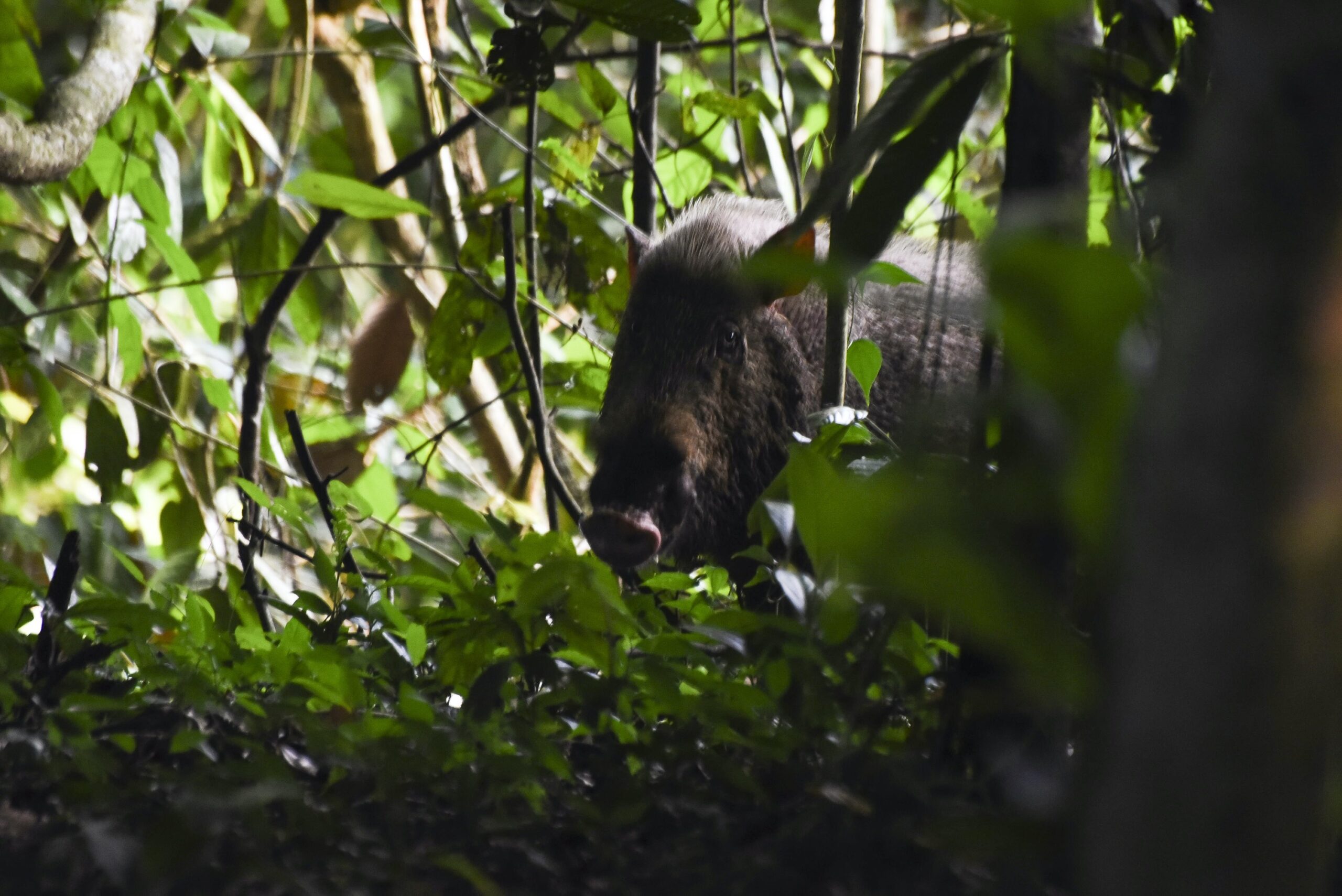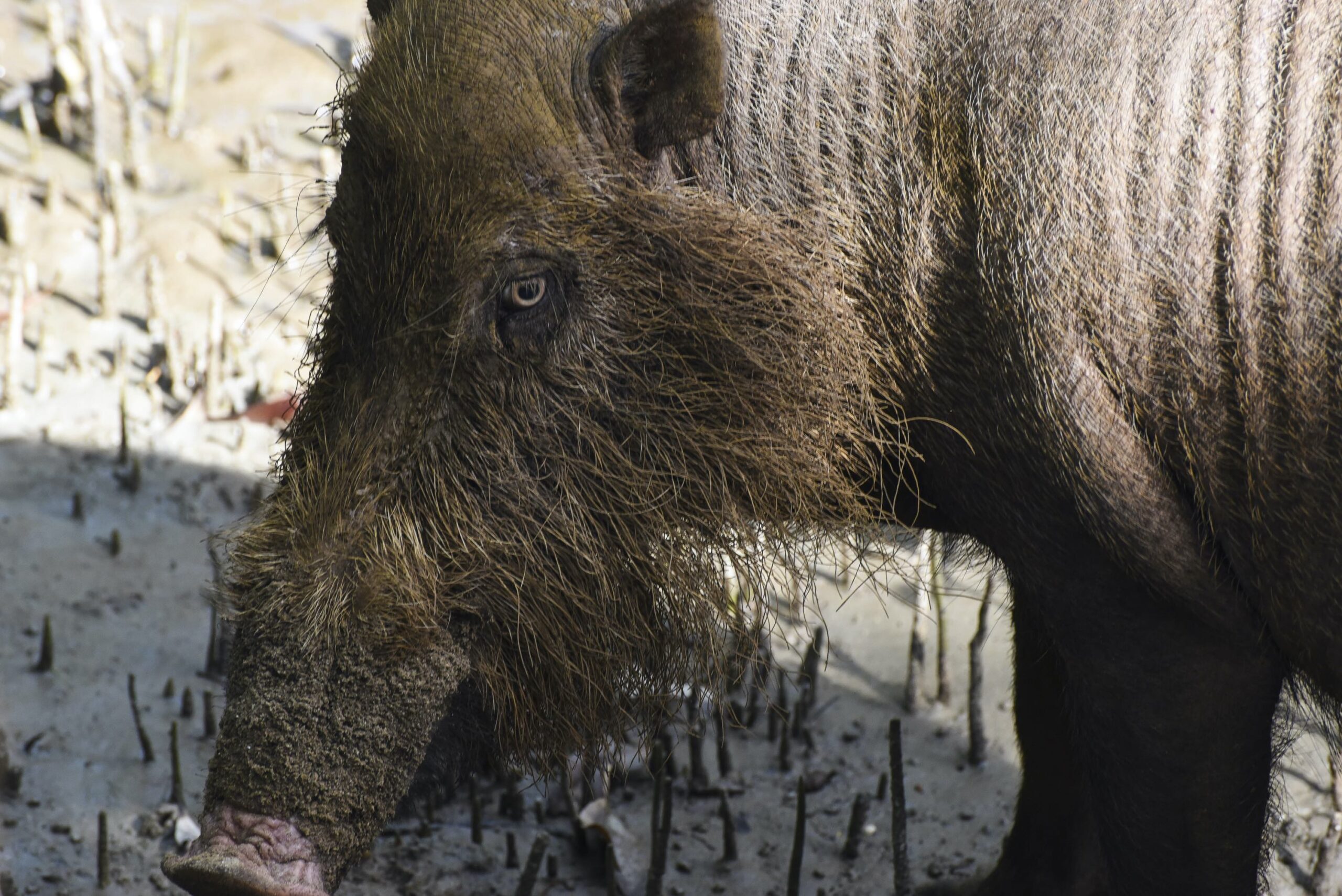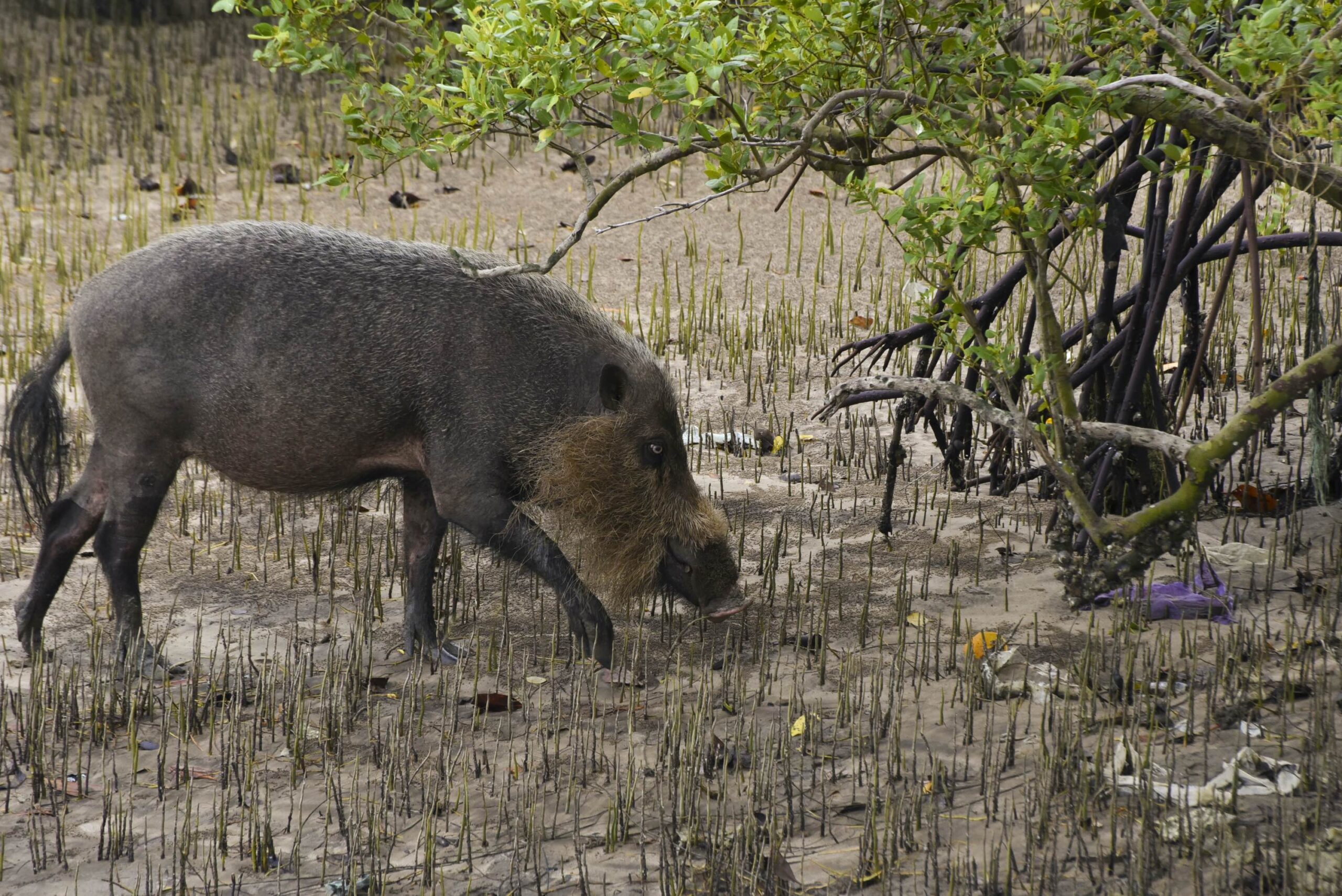- Oil palm expansion and urbanization have altered the traditional hunting of bearded pigs by the Indigenous Kadazandusun-Murut (KDM) community in Sabah, Malaysia, a new study has found.
- Researchers interviewed 38 hunters on changes in pig behavior and hunting practices before the African swine fever (ASF) epidemic hit Sabah in 2021.
- They found that even though pig hunting patterns have changed dramatically, the activity remains a cornerstone of KDM communal culture for food, sport, gift-giving, festivals and celebrations.
- As ASF devastates wild pig populations, the researchers’ findings highlight a need for long-term hunting management that conserves both the bearded pig and Indigenous cultural traditions.
It’s easier to spot the bristly, gray-brown hide of a Bornean bearded pig (Sus barbatus) ambling through orderly rows of oil palm trees, than amid a dense tropical forest. But modern-day pig hunting in plantations brings its own challenges. The animals are more skittish. They are sensitive to the sound of gunshots and the smell of gunpowder. Once aware of a human presence, they bolt.
It wasn’t always this way. Indigenous Kadazandusun-Murut (KDM) hunters, who have for centuries tracked wild pigs through the forests of Sabah, Malaysia, reported that their prey never used to be so fearful of humans. In the past, pigs that encountered hunters “wouldn’t run,” but “only looked.”
Today’s pigs, however, are smarter: quicker to flee and harder to catch. “Now the pig has got a high school certificate,” hunters told researchers, in a new study published August in People and Nature. The study, which investigates how KDM bearded pig hunting practices have changed in recent decades with oil palm expansion and urbanization, found it wasn’t just the pigs’ behavior that was different: hunting patterns had adapted in response, too.

Previously, hunters mainly headed to forests or mangroves to hunt pigs in traditional ways: with dogs and a spear, on foot with a gun, or using snares. But as industrial and smallholder oil palm plantations steadily replace forests, pigs and hunters are increasingly altering their behavior and practices to fit this new landscape.
According to hunters, waiting for pigs to appear in plantations is often more fruitful than actively searching for them in forests. “In the plantation you know the pig will come eventually — it’s only a matter of time,” one said. In the forest, “it’s not as certain even if you hunt all day long.”
Not only are the pigs easier to spot in plantations, their arrival and location are more predictable. Drawn to the abundant palm fruits in plantations, pigs have been known to time their appearances for the hours when oil palm workers are not around, in the early evenings or at night.
But predictable behavior doesn’t always translate to a successful hunt, according to the study. Pigs foraging in palm fruit-rich plantations employ a “high-risk, high-reward” strategy and therefore tend to be more skittish, with elevated flight responses, the researchers wrote — making them harder to catch.

Because bearded pigs have for centuries been so common in Sabah, the hunting and consumption of their meat is a cornerstone of traditional KDM culture. Even as oil palm expansion and urbanization changed cultural traditions, researchers witnessed bearded pig hunting practices enduring in “powerful ways.”
“A lot of the hunters we interviewed still hunt for the same reasons — food, sport, gift-giving and pest control,” David Kurz, first author of the study and a wildlife ecologist at Trinity College, Hartford, in the U.S., told Mongabay. “Many of their same customs still take place, with bearded pig meat shared at cultural celebrations and feasts, and other community events. There is a very strong attachment between KDM people and bearded pigs that continues today.”
But as oil palm plantations spring up in places where their forest habitats once were, and as wild pig populations slump under the African swine fever (ASF) epidemic, a creature once so ubiquitous could be lost.

From 1990 to 2010, the encroachment of oil palm and rubber plantations across the forests of Peninsular Malaysia, Sumatra and Borneo deforested and fragmented more than 20% of key bearded pig habitat. With wild populations falling more than 30% in the past two decades, the species was categorized as vulnerable in 2017.
Today, the ASF epidemic is lending fresh urgency to conservation efforts. Previously unknown to the immune systems of pigs in Southeast Asia, the virus has spread rapidly through Sabah’s numerous forests and districts since the start of this year. While harmless to humans, ASF is deadly to wild and domestic pigs alike, with fatality rates ranging from 48% to 100%.
“[The emergence of] African swine fever is a massive development. It came to Sabah after our study,” Kurz said. “Our study talks about how important the pigs are to local people, but now most of the pigs in Sabah have perished because of this virus.
“It’s a really big deal,” he added. “It means people can’t eat it at nearly the same rate anymore. It may mean they can’t preserve and pass on their cultural traditions.”

But bearded pigs are a “very resilient” species with high reproductive rates, says Benoît Goossens, director of the Danau Girang Field Centre in Sabah and a co-author of the study. A female can birth between three and 10 piglets per litter, two litters a year.
“We have evidence collected from camera traps in several protected areas that some bearded pig individuals have survived, although the numbers are extremely sporadic,” Goossens said in a statement. “[If] some individuals survived the outbreak, the population could bounce back in a few years.”
In the meantime, it’s “important for people to not hunt them if they have that option,” Kurz said. “We need to give the pigs a chance to recover.”

In Sabah, it’s legal to hunt bearded pigs for both sport and commercial reasons with the appropriate licenses. To mitigate the spread of ASF, and due to COVID-19 movement restrictions in force, the local government froze the issuance of hunting licenses in February.
Kurz called such actions “helpful” in the short term. “In the long run, depending on how the pigs are doing in different places, we might have to think about translocation or additional protection,” he said, adding that any new conservation measures should be discussed with Indigenous communities beforehand to “preserve culturally important practices and ensure food security.”
Before the ASF outbreak, Kurz and his colleagues had recommended local authorities and conservation managers consider location-specific management approaches to bearded pig hunting, such as regulating subsistence wild meat consumption by a separate standard from commercial sale.

Interviews with dozens of hunters highlight the importance of pig hunting in KDM communal culture for food, sport, gift-giving, festivals and celebrations.
“If you take the pig away, you lose a lot of different threads in these Indigenous culture groups in Borneo,” Kurz said. “We need to think carefully about bearded pig conservation, but also sustainable hunting to preserve cultural traditions.”
Banner image of a bearded pig peering through the forest. Image courtesy of Jessica Suarez.
Citations:
Kurz, D. J., Saikim, F. H., Justine, V. T., Bloem, J., Libassi, M., Luskin, M. S., … Potts, M. D. (2021) Transformation and endurance of Indigenous hunting: Kadazandusun-Murut bearded pig hunting practices amidst oil palm expansion and urbanization in Sabah, Malaysia. People and Nature. doi:10.1002/pan3.10250
Ke, A., & Luskin, M. S. (2019) Integrating disparate occurrence reports to map data-poor species ranges and occupancy: A case study of the vulnerable bearded pig Sus barbatus. Oryx, 53, 377-387. doi:10.1017/S0030605317000382
FEEDBACK: Use this form to send a message to the author of this post. If you want to post a public comment, you can do that at the bottom of the page.